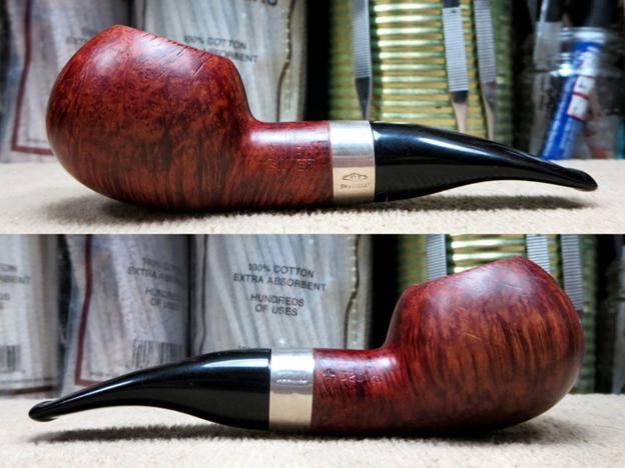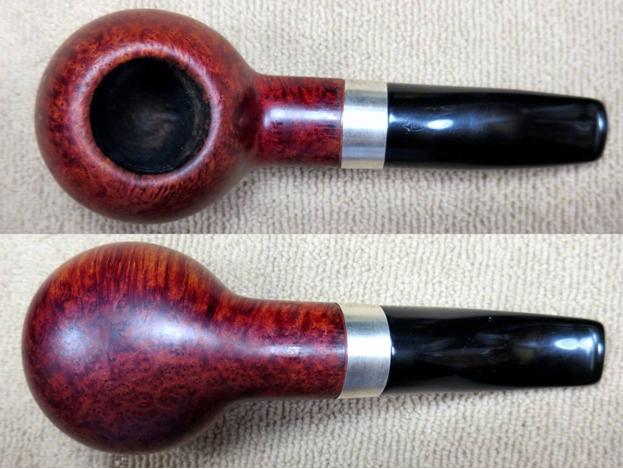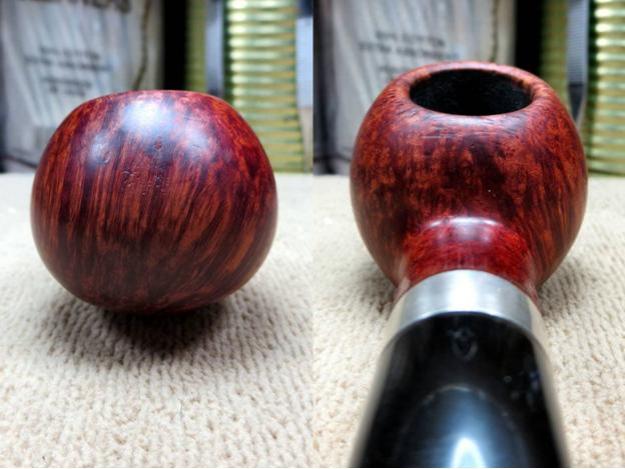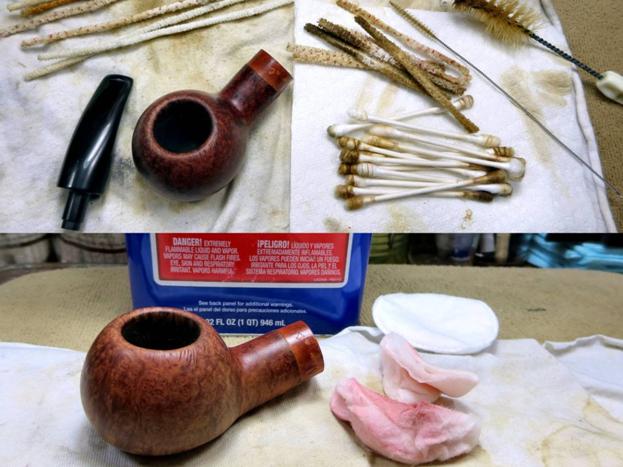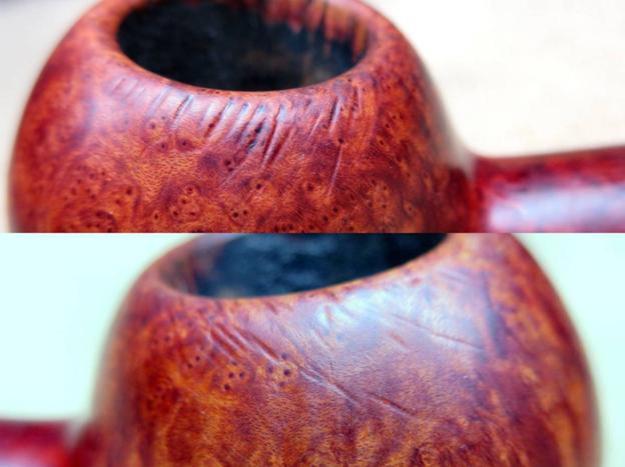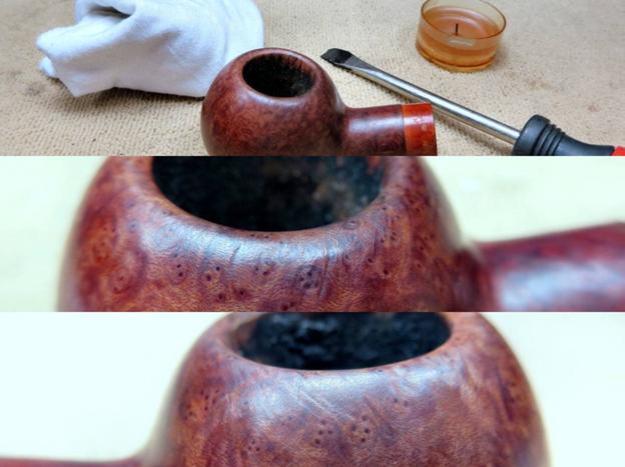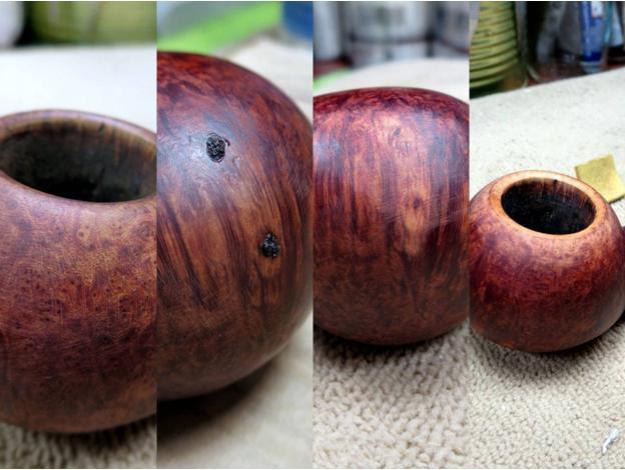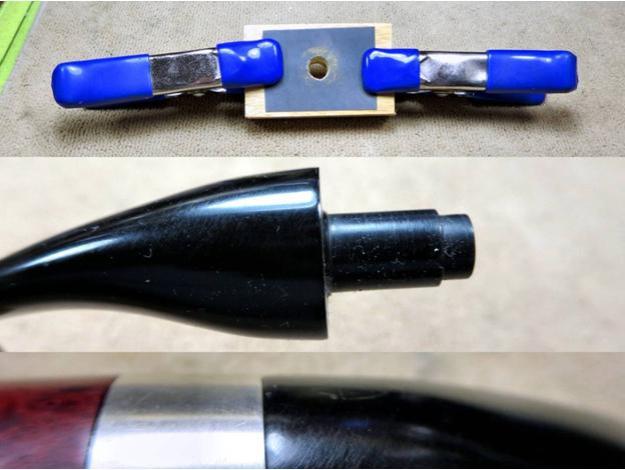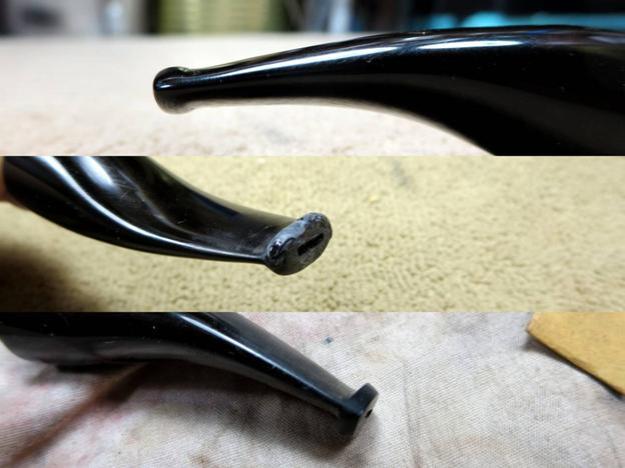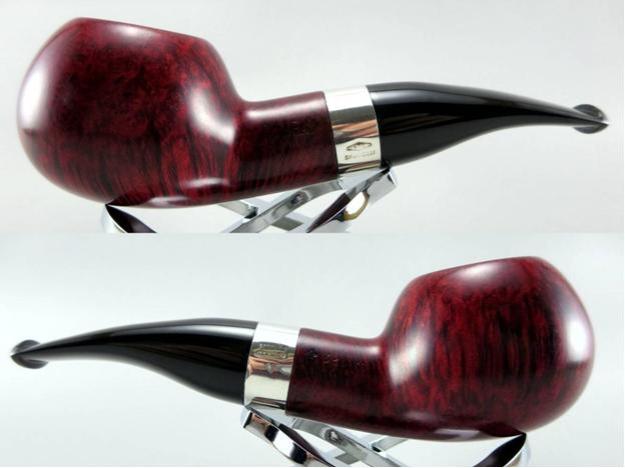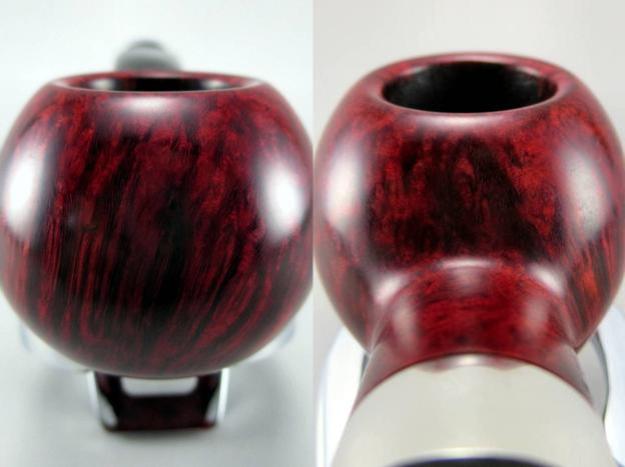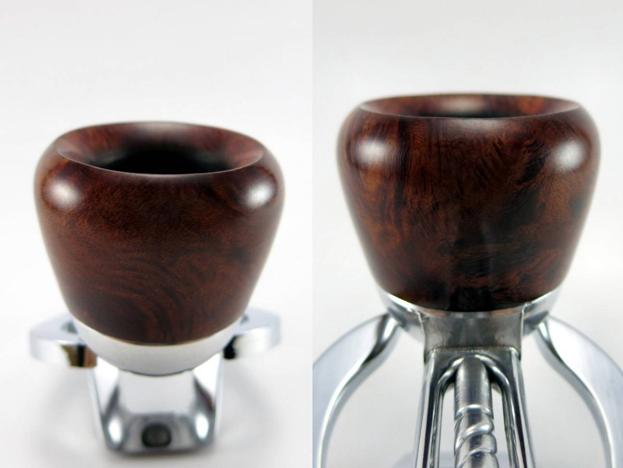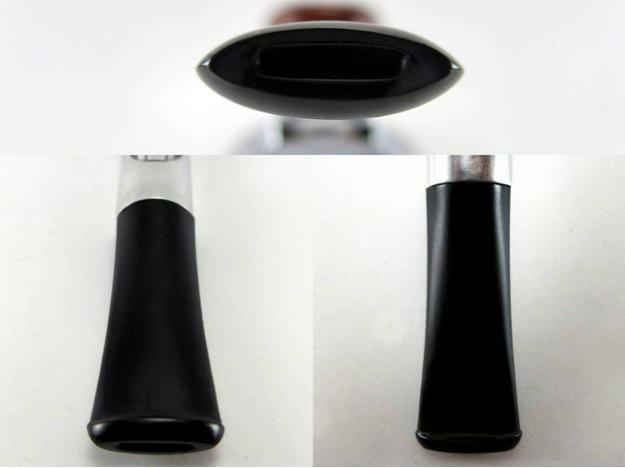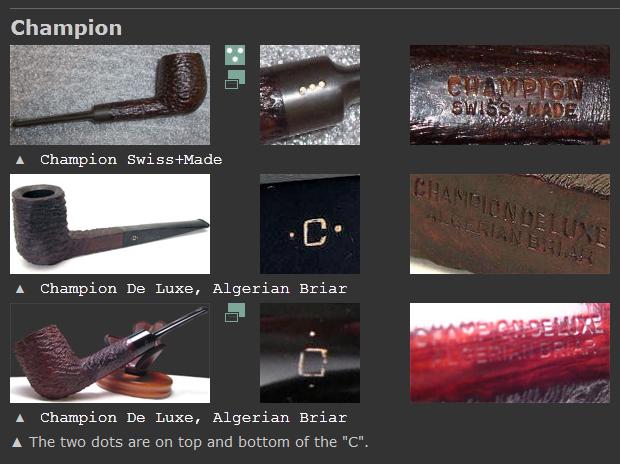Blog by Anthony Cook
The second pipe sent to me by my PSU friend for some work is a unique one. Let me introduce you to the Mokin Corsaire 7087. It’s a small pipe, just shy of five inches in length and about one and a quarter inches tall at the bowl. It has an author-ish shape, except that there is a spine that runs along the bottom like the keel on a ship. I suppose that’s where the “Corsaire” comes from, but despite the masculinity in that name, to my eye there is something distinctly feminine in the shape. The condition of this one was rough to put it mildly. The stummel had some fairly heavy scratches and dents. The rim was scorched and there was a divot on one side where the wood had been burned away. The briar was unstained but covered in a thick, tinted lacquer coating. I suppose this was done to help hide the many fills, but the lacquer wasn’t thick enough to prevent the black stain on the bottom from seeping through into the grain. Oh, did I mention the beautiful horn stem with the busted face and a crack that ran along half the length on the underside? Yeah, like I said, rough.
The condition of this one was rough to put it mildly. The stummel had some fairly heavy scratches and dents. The rim was scorched and there was a divot on one side where the wood had been burned away. The briar was unstained but covered in a thick, tinted lacquer coating. I suppose this was done to help hide the many fills, but the lacquer wasn’t thick enough to prevent the black stain on the bottom from seeping through into the grain. Oh, did I mention the beautiful horn stem with the busted face and a crack that ran along half the length on the underside? Yeah, like I said, rough.
Here are some more triage photos:
 Stamping detail:
Stamping detail: I gave the pipe a thorough internal cleaning, and then stripped off the lacquer finish with acetone and cotton pads. The lacquer lifted easily but it was a mess. It turned into a thick, sticky residue when it came into contact with the acetone. Once the stummel was clean, the grain became more apparent and it was stunning! I’m a bit of a grain-hound. So, I already knew that I was going to have to work that up as best I could.
I gave the pipe a thorough internal cleaning, and then stripped off the lacquer finish with acetone and cotton pads. The lacquer lifted easily but it was a mess. It turned into a thick, sticky residue when it came into contact with the acetone. Once the stummel was clean, the grain became more apparent and it was stunning! I’m a bit of a grain-hound. So, I already knew that I was going to have to work that up as best I could.
I scrubbed at the dark stain on the bottom with the same acetone dampened pads to try to lift it or at least lighten it, but the attempt was in vain. The acetone didn’t even put a dent in it. I was fresh out of ideas and thought that I would probably have to sand them out, but before I did that, I shot Steve an email explaining the problem. He suggested that I try lemon juice. It seemed counterintuitive to me. What could lemon juice do to a stain that acetone couldn’t touch? Anything is worth a shot when you’re desperate though. So, I gave it a try and it worked amazingly well! The only stain that remained was what had set into the softest grain and that was something that I could work with. With the tinted lacquer removed, the fills were more evident than ever. There were seven of them in all and a couple of them were quite large. That’s a lot for any pipe, but especially so for a stummel this small. I picked each of them out and patched the pits with CA and a mix of fine briar dust and course briar file shavings. I find that the course shavings take the stain better, but the fine dust is a better mix with the CA. When mixed together, the resulting patch is still dark but it is mottled with lighter areas that will accept stain well.
With the tinted lacquer removed, the fills were more evident than ever. There were seven of them in all and a couple of them were quite large. That’s a lot for any pipe, but especially so for a stummel this small. I picked each of them out and patched the pits with CA and a mix of fine briar dust and course briar file shavings. I find that the course shavings take the stain better, but the fine dust is a better mix with the CA. When mixed together, the resulting patch is still dark but it is mottled with lighter areas that will accept stain well.
I sanded out each of the patches with 220-grit and 320-grit paper and topped the bowl with the same grits until the majority of the burned wood around the rim was removed. Then, I gave a slight chamfer to the inner rim to soften the edge and lightly sanded the entire stummel with 320-grit paper to remove most of the scratches.
It was while I was sanding the stummel that I noticed that the carving was a little sloppy. The left side of the stummel was noticeably less rounded than the right, which made the stummel appear a little lopsided. It was obvious that it wasn’t intentional, but I debated with myself whether to try to correct it or preserve it as part of the personality of the pipe. In the end, I chose to split the difference and round off the upper and lower areas of the left side for a better match with the right. The stummel was ready for finishing. So, I moved on to address the damage to the stem. Usually, I would drill a small hole at the end of the crack to stop the run. In this case, however, that wasn’t really an option. The main crack that extended up from the stem face fractured into several short, stair-step cracks at the end. I decided that it would be best to just seal and stabilize them and hope for the best.
The stummel was ready for finishing. So, I moved on to address the damage to the stem. Usually, I would drill a small hole at the end of the crack to stop the run. In this case, however, that wasn’t really an option. The main crack that extended up from the stem face fractured into several short, stair-step cracks at the end. I decided that it would be best to just seal and stabilize them and hope for the best.
I wrapped clear tape around a thin bit of cardboard and cut a hole for the tenon to push through. This little contraption would serve a dual purpose as both a method for keeping the patched area of the stem face relatively flat and even, and also as stand to support the stem while the patches dried. I patched the cracks and holes with baking soda and CA in the same manner that I would apply a briar dust and CA patch on the stummel. I use super-thin CA for patches. It has about the same viscosity as milk and I think that it penetrates better into the dust than standard CA. It can be tricky to work with until you get used to it. Even though I’ve kind of gotten a handle on it by now, you can see in the photo below that it still got away from me a bit in the bend of the stem. I also filled a couple of bite marks on either side of the stem and when all the patches were fully dry, I sanded them out with 220-grit and 320-grit paper. The cracks were fairly tight. So, I didn’t get as much baking soda worked into them as I would have liked and they appear dark in the photo below. They are sealed and smooth to the touch though.
I also filled a couple of bite marks on either side of the stem and when all the patches were fully dry, I sanded them out with 220-grit and 320-grit paper. The cracks were fairly tight. So, I didn’t get as much baking soda worked into them as I would have liked and they appear dark in the photo below. They are sealed and smooth to the touch though.
I continued to sand with 400, 600, and 1200-grit paper to smooth the surface. I used a drop of mineral oil between each grit. The oil allows the sanding dust to collect as slurry on the stem rather than build up on the paper. It also moisturizes the horn, which keeps the ends of the fine fibers from raising and splintering. A good polish with the full range of Micro-Mesh pads finished up the work on the stem. I knew from the beginning that I couldn’t leave the finish natural. There were just too many fills for that. I also knew that I couldn’t completely hide them. So, I hoped that I could give the grain enough “pop” with a bit of stain to draw the eyes away from them.
I knew from the beginning that I couldn’t leave the finish natural. There were just too many fills for that. I also knew that I couldn’t completely hide them. So, I hoped that I could give the grain enough “pop” with a bit of stain to draw the eyes away from them.
I applied four stains in all; dark brown, medium brown, light brown, and British tan. The first three were thinned with three parts isopropyl alcohol to one part stain. The last stain was thinned by eye until it was just a light wash. I applied the first stain, and then sanded with 400-grit paper. The second stain was applied before sanding with 600 and 1200-grit paper. After the third stain, I polished the stummel with 1500 through 4000-grit Micro-Mesh pads and gave the stummel a Tripoli buff on the buffing wheel. Then, I applied the stain wash and finished up the work on the stummel with the remaining Micro-Mesh grits. All sanding up to 3600-grit Micro-Mesh was wet sanded and the stummel was hand-buffed with a soft cloth after each stain to remove any excess.
Finally, I polished up the brass ferrule with Semichrome polish and used a bit of epoxy to affix it to the stummel. All that remained after that was to buff the pipe with White Diamond and apply several coats of carnauba wax before it was time for some photos.
 I know that many may regard this one as just a novelty pipe, but despite the rough edges, it may be my favorite refurbishment work to date. The photos barely do justice to the color or the grain on this pipe. The credit for the transformation is not really mine though. This was one of the most cooperative pipes that I’ve ever worked with. It set on the bench and said, “Make me a star.” I was charmed and did the best that I could.
I know that many may regard this one as just a novelty pipe, but despite the rough edges, it may be my favorite refurbishment work to date. The photos barely do justice to the color or the grain on this pipe. The credit for the transformation is not really mine though. This was one of the most cooperative pipes that I’ve ever worked with. It set on the bench and said, “Make me a star.” I was charmed and did the best that I could.





